This is an Exa 1c, a 35mm SLR camera sold under the name Ihagee, but manufactured by Certo Camera Werk in Dresden, East Germany, who at the time were both part of VEB Pentacon. The Exa 1c was produced for less than three years and was the last in the Exa series of SLR cameras, originally built by Ihagee starting in 1950 and the last camera ever to be made bearing the name “Ihagee”. The Exa 1c does not use the original Exakta bayonet lens mount popularized by the original Kine Exakta camera from the 1930s and instead uses the M42 screw mount. As with all Exa models, it was aimed at the amateur photographer, featuring a limited shutter and a simplistic feature set.
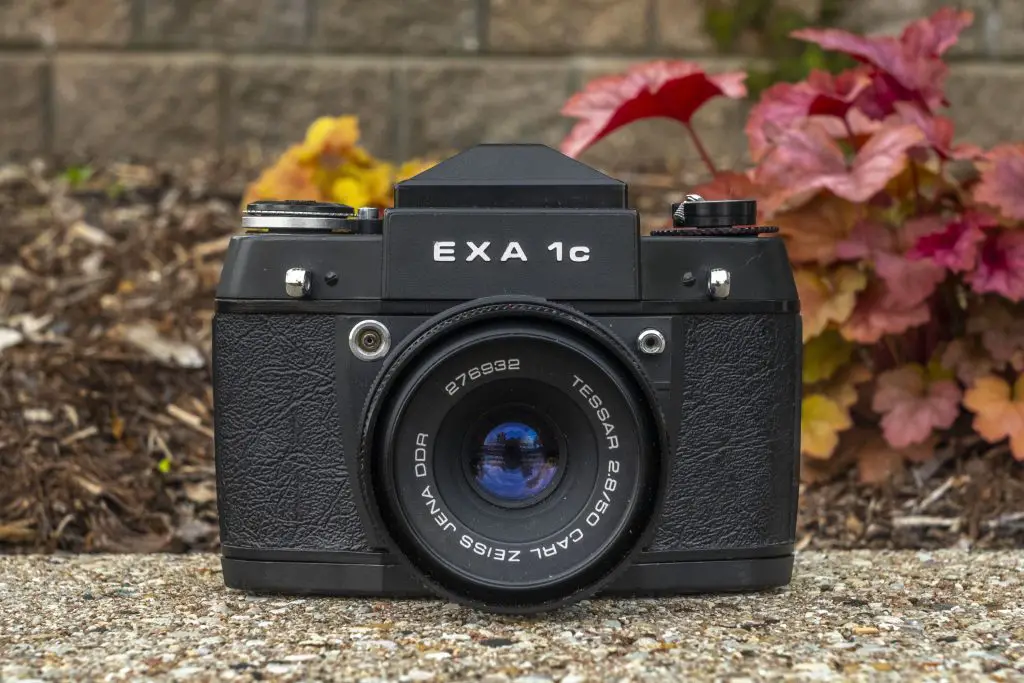 Film Type: 135 (35mm)
Film Type: 135 (35mm)
Lens: 50mm f/2.8 Carl Zeiss Jena Tessar coated 4-elements
Lens Mount: M42 Screw Mount
Focus: Variable
Viewfinder: Interchangeable SLR Pentaprism
Shutter: Guillotine-style Behind the Lens
Speeds: B, 1/30 – 1/175 seconds
Exposure Meter: None
Battery: None
Flash Mount: PC M and X Flash Sync
Weight: 662 (w/ lens), 493 grams (body only)
Manual: http://www.ihagee.org/Manuals/ECM108-ExaIcGebrauch86.pdf
How these ratings work |
The Exa 1c is the last remnant in the long and successful lineage of the Ihagee Exakta. Evolved from the original 1950 Exa, the 1c uses the same interchangeable viewfinders, shares a vaguely similar body shape, and retained the left hand shutter release, but not much else. This is a very basic camera with a limited 5 speed shutter, uses the M42 screw mount, and lacks modern conveniences like an automatic resetting exposure counter or any kind of information in the viewfinder. It’s saving grace is the “kit” lens that usually came with it, a Zeiss Tessar 50/2.8 lens which like every Tessar that came before it, is capable of really nice images. | ||||||
| Images | Handling | Features | Viewfinder | Feel & Beauty | History | Age | |
| 2 | 1 | 0 | 0 | 1 | 0 | 0% | |
| Bonus | none | ||||||
| Final Score | 4.0 | ||||||
History
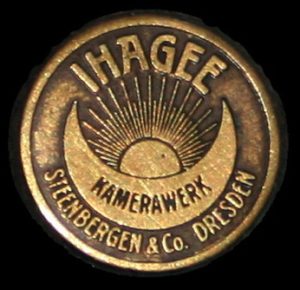 Ihagee was founded in 1912 by a Dutchman named Johan Steenbergen as Industrie-und Handelsgesellschaft which stands for Industry and Trade Society. Often referred to by the nickname IHG, the company name was eventually shortened to Ihagee Kamerawerk since Ihagee is pronounced the same in German as saying “I H G”. I should point out that contrary to how it appears, there is no “J” in Ihagee. Many people incorrectly list this company as Jhagee.
Ihagee was founded in 1912 by a Dutchman named Johan Steenbergen as Industrie-und Handelsgesellschaft which stands for Industry and Trade Society. Often referred to by the nickname IHG, the company name was eventually shortened to Ihagee Kamerawerk since Ihagee is pronounced the same in German as saying “I H G”. I should point out that contrary to how it appears, there is no “J” in Ihagee. Many people incorrectly list this company as Jhagee.
In the early years, Ihagee produced a variety of plate and roll film cameras, but it wasn’t until their release of a solid bodied single lens reflex camera called the Exakta where the company began to make a name for itself. Desgined by Karl Nüchterlein, the original Exakta made it’s debut in 1933 and used 127 roll film. It was the first single lens reflex camera to use 127 film.
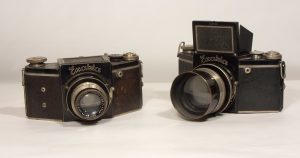
Today, this original camera is unofficially called the VP, or Vest Pocket Exakta to differentiate itself from a later model, also called the Exakta that was designed for 35mm film which made it’s debut in 1936. Although sharing the same name and same general trapezoidal shape, the Kine Exakta was quite a bit more sophisticated than the VP Exakta. Featuring an all new bayonet Exakta lens mount and interchangeable viewfinders, the 35mm version earned the nickname of “Kine Exakta” because at the time, 35mm film was still considered by many to be cinema (or kine) film.
The Exakta would go on to become one of the most popular and successful 35mm “system” cameras and a huge number of lenses and other accessories were made for it. Exaktas were used by amateur and professional photographers, the military, and even in scientific applications. The Exakta would receive regular updates, tweaking the design and adding new features and would stay in continuous production until 1972, at which time, the Exakta name would be used on an unrelated 35mm SLR designed by (then) parent company VEB Pentacon, called the Exakta 1000 RTL.
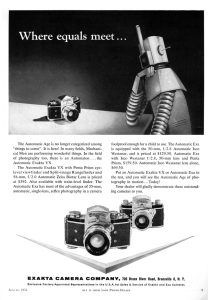
Although tremendously successful, the Exakta wasn’t cheap. It was a fully featured camera with an advanced shutter, and supported a whole host of high quality lenses and accessories. For the amateur photographer who wanted the benefits of the Exakta system, but not the high price, in 1950 Ihagee would release a scaled down and less expensive version of the Exakta Varex called the Exa. The Exa would feature a similar looking body that supported the same bayonet lens mount and interchangeable viewfinders, but offered a much simpler shutter with a top speed of 1/150 and lacked other features such as the cassette to cassette transport system.
The ad to the right from the August 1955 issue of Modern Photography lists an Exakta VX with pentaprism viewfinder and 58mm f/2 Zeiss Biotar lens for $392. Comparatively, an Exa with waist level finder and 50mm f/2.8 Isco Westanar lens cost $129.50. Upgrading the Exa with a pentaprism viewfinder brought the price up to $159.50, still less than half that of the Exakta. When adjusted for inflation, these prices are comparable to $3730, $1230, and $1520 respectively.
Like it’s bigger brother, the original Exa (later renamed the Exa 1a) would receive numerous cosmetic and functional improvements over the years and would remain in production until 1977. In 1959, an alternate version of the Exa, called the Exa II would be produced concurrently with the original Exa which featured a fixed pentaprism viewfinder, a cloth focal plane shutter with speeds up to 1/250, a film advance lever and a revised body, but otherwise still supported the same lenses as it’s bigger brothers. The Exa II would later be renamed either Exa 500, Exakta 500, or VX 200 depending on market, and it’s shutter improved to support a top 1/500 shutter speed. The Exa II/500 series would be discontinued in 1970, around the time of Ihagee’s acquisition by VEB Pentacon.
With the discontinuation of the Exa 1a in 1977, a replacement model produced entirely by VEB Pentacon sharing a similar body but now supporting the M42 screw mount instead of the original Exakta bayonet, was released called the Exa 1b. The Exa 1b still supported the use of Exakta viewfinders, but with it’s new lens mount, is not considered by most Exakta collectors to be of the original Exakta family.
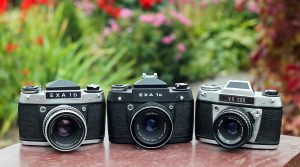
Over the next several years, the Exa 1b would continue to be cheapened with several pieces of the camera replaced by plastic instead of metal like on the original. In 1985, production of the Exa would switch from Pentacon’s main Dresden plant to that of another Pentacon company, Certo Camera Werk. Shortly after production was switched to Certo, the Exa 1b would be renamed the 1c, without any other changes. Production of the Exa 1c would end in 1987 officially ending the lineage of cameras dating back to the original 127 roll film Exakta from 1933.
Little is known about who the Exa 1c was marketed to. I found no advertising material, no reviews, and no evidence that it was ever on sale here in the US. I contacted Hugo Ruys from ihagee.org, one of the most comprehensive sites about all things Ihagee, and he responded that he has absolutely no information about the 1c. Obviously it did exist, otherwise I wouldn’t have one, but who bought it, or for how much is anyone’s guess.
Edit 7/25/19: I was contacted by Hugo Ruys of ihagee.org, who recently found this German language brochure for the Exa 1c. It’s not in English, but still offers a glimpse of how this camera was marketed upon it’s release. Thanks Hugo!
Today, these later Exas are collectible, only if for their curiosity. Compared to anything else being made in the mid 1980s when this model was in production, this camera was a relic from a bygone era. If you can find one cheaply, it’s rudimentary design means it will still likely work fine, and with it’s Zeiss Tessar lens, it’s still capable of good photographs.

My Thoughts
What is a camera? In it’s most basic form, a camera is a light tight box with something, usually a lens, that focuses light onto a specific surface with some type of light sensitive material (film or a digital sensor). A camera can be as simple as a ‘camera obscura’ or a box camera, all the way to the most state of the art full frame digital mirrorless cameras.
While we often associate the simplest of cameras to also have simple lenses, what happens when you take a very simple camera and put a good lens on it? If that was a question you’ve ever wondered about, the Exa 1c is your answer.
Produced from 1985 – 1987, the Exa 1c is laughably outdated in every way, The camera’s shutter dates back to the original Exa from 1950 and has a top speed of 1/175 second, a top speed common with folding Kodaks from the 1930s. I used to think that 35mm cameras had one of two types of shutter, either a focal plane (cloth or metal) or a leaf shutter. The Exa has a third, which can only be described as a sort of ‘guillotine’ style, in which there is a curved opening beneath the reflex mirror that opens with a spring loaded flap that closes fractions of a second after the mirror flips up upon releasing the shutter. The only other camera I’ve ever seen with a shutter like this is the Chinese made Continental TXL that itself was a copy of the Fujica ST-F. Rather than attempt to explain it in words, here are three images of the shutter in it’s resting (mirror up), cocked (mirror down), and open states.
In the first image, you can see the shutter in it’s resting stage. The shutter is not cocked, the mirror is up, and the viewfinder is blanked out. Upon winding the film advance lever, the mirror drops, allowing light to pass through to the viewfinder, and the shutter is cocked. When the shutter release is pressed, the mirror swings back up, momentarily opening a rectangular window in the curved metal plate beneath it, then depending on the shutter speed set, a door will close behind the mirror, covering up the window. In the third image above, I have the camera in Bulb mode to keep it open, as normally this window would be open too short of a time for me to capture an image. It’s a rudimentary system, but does seem to work well, albeit with a very limited selection of speeds.
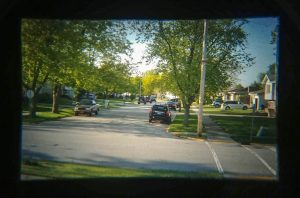
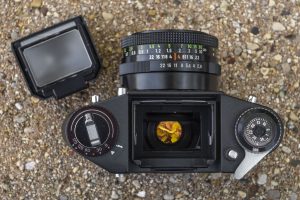
The viewfinder is interchangeable, allowing for both a pentaprism or an optional waist level finder. The ground glass focusing screen is extremely basic, showing no meter, no indication of the settings of the camera, not even any kind of focus aide like a split image rangefinder or microprism circle. There’s literally nothing other than a large swath of froster glass. Thankfully, the camera does support automatic M42 lenses, allowing you to compose your images with the lens wide open. Strangely, the German language manual that came with my Exa 1c shows a focusing screen with a split image focus aide and microprism collar that may have been available for it. Since Exakta viewfinders contain the focusing screen, it is possible that this camera optionally came with such a viewfinder.
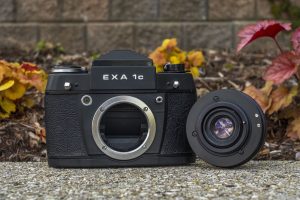
Earlier Exas used the original Exakta lens mount which dates back to the 1930s, and fell out of favor with professional photographers in the 1960s. Replacing it was the venerable M42 mount which itself dates back to the late 1940s, hardly an advancement. Yet, with a new mount, it allowed access to a huge library of excellent lenses made by companies all over the world. Schneider and Zeiss lenses from Germany, Asahi Pentax Takumars and Yashica Yashinon lenses from Japan, and even Soviet era Helios lenses were all made using the M42 mount and are compatible with the Exa 1c.
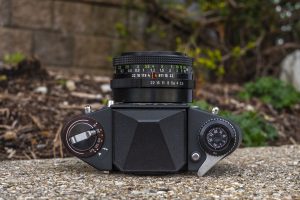
The top plate of the camera is dominated by the pentaprism viewfinder in the middle. On the left side of the prism is the fold out rewind knob and shutter speed dial. Strangely, the shutter speed dial has no click stops for each of the 5 indicated speeds plus bulb. It just smoothly rotates from the fastest 1/175 speed down to B which causes me to have serious concern about the accuracy of each speed. Notice that there is no top plate shutter release. Like all Exa and Exaktas that came before it, the Exa 1c’s shutter release is on the front of the camera, near the 2 o’clock position around the lens mount.
On the right side of the prism where you might expect the shutter release is a chrome film rewind button that you must press and hold when you are ready to rewind your film back into the cassette. When I first got this camera, I had thought that perhaps this was a lock release for the viewfinder, but on mine the viewfinder can be removed with or without this button pressed in, so that couldn’t be it. Next to the chrome button is the film advance lever with combined manually resetting exposure counter and film reminder dial.
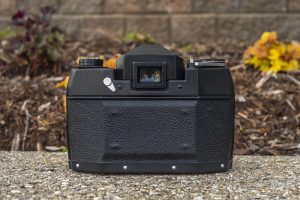
The back of the camera shows the somewhat large rectangular viewfinder, and to the left a shutter release lock. With this lever in the down position, a red dot is exposed which prevents the shutter from being fired. You must move this lever to the position covering the red dot to unlock the shutter release. The first time I handled this camera, I mistakenly thought the shutter was seized, but it was just locked.
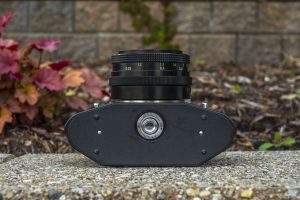
The bottom of the camera is about as bare as it gets, featuring a metal 1/4″ tripod socket with a metal ring around it that functions as the film door release. There is a red dot on this ring and another on the bottom plate, with these two dots lined up, the entire back and bottom of the camera comes off in one piece. To lock the door, rotate this ring 90 degrees so the dot is facing the rear of the camera.
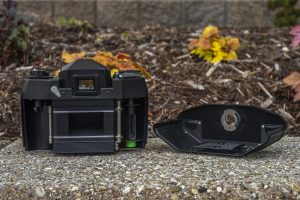
The film compartment is one of the few areas in which Certo’s attempts to cheapen the camera are less obvious. There are metal rollers and a double geared feeler shaft, along with polished metal film rails, and all metal cassette forks. This might seem like me grasping at nice things to say about the camera, but I’ve seen worse. Film transport is from left to right onto a removable plastic take up spool. The spool is notched in two places, somewhat simplifying film loading.
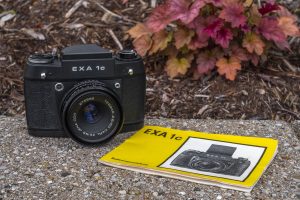
So back to my original question of what happens when you mount a quality lens to a basic camera, this is your answer. The Exa 1c is about as basic of a camera as you can get. It’s rudimentary shutter and featureless viewfinder is outclassed by nearly every camera made since the mid 20th century. Yet, like a box camera, when you work within it’s strengths is capable of some really nice images.
I doubt anyone reading this article would buy into me calling the Exa 1c a box camera, so maybe I should call it an Single Lens Reflex Light Box…a SLRLB! Hmm, maybe I should copyright that!
My Results
I have to admit, I was both dreading and looking forward to using the Exa 1c. I figured that the reputation of the Zeiss Tessar lens should produce some pretty decent looking shots, but the rudimentary feature set of the camera might make it a chore to use. Not wanting to keep this camera sitting idle too long, I loaded up a semi-expired bulk roll of Kodak Plus-X 125. I had shot this film before and knew it was still usable at box speed so I figured the film’s 125 speed would be an ideal match for the Exa’s limited shutter speeds.
The images from the Exa are as good as you might expect from any camera with an M42 Tessar and for that, I’d say it performed well. In fact, with the screw mount Tessar attached, the camera likely has more value, simply for the lens which can be used on any other M42 screw mount film camera, or even adapted to digital.

Frankly, that’s the best thing I can say about it though. I fully understand the need for simple, all mechanical cameras that leave 100% of the photo making decisions up to the photographer, but for a camera that made it’s debut in 1985 when even the simplest of point and shoot cameras could create photographs equally as good, and with less effort, I have to ask why this camera exists at all.
Who was it’s intended customer? Why would anyone choose a camera with a feature set that matched cameras from 20-30 years prior? Perhaps, I just don’t understand the economy of Cold War era East Germany in the 1980s. Looking back from a historical perspective, this camera’s mere existence makes no sense. With a large number of mechanical Prakticas that used the same lens mount, and with more capable shutters and viewfinders, I simply don’t understand why anyone would buy it.
But they did. It’s certainly not a common model, but it was easy enough for me to find cheap, and a quick look at eBay returns at least 10 more, so some had to have been sold and I guess when you look at it purely from a functional perspective, it does work, and as the gallery above shows, it made nice photos.
Related Posts You Might Enjoy
External Links
https://camerapedia.fandom.com/wiki/Exa_1c
http://oldgoodlight.blogspot.com/2016/10/cool-cameras-6-barebones-exa-1c.html
https://www.photo.net/discuss/threads/exa-1c-more-on-the-last-of-the-breed-1985-87.508716/

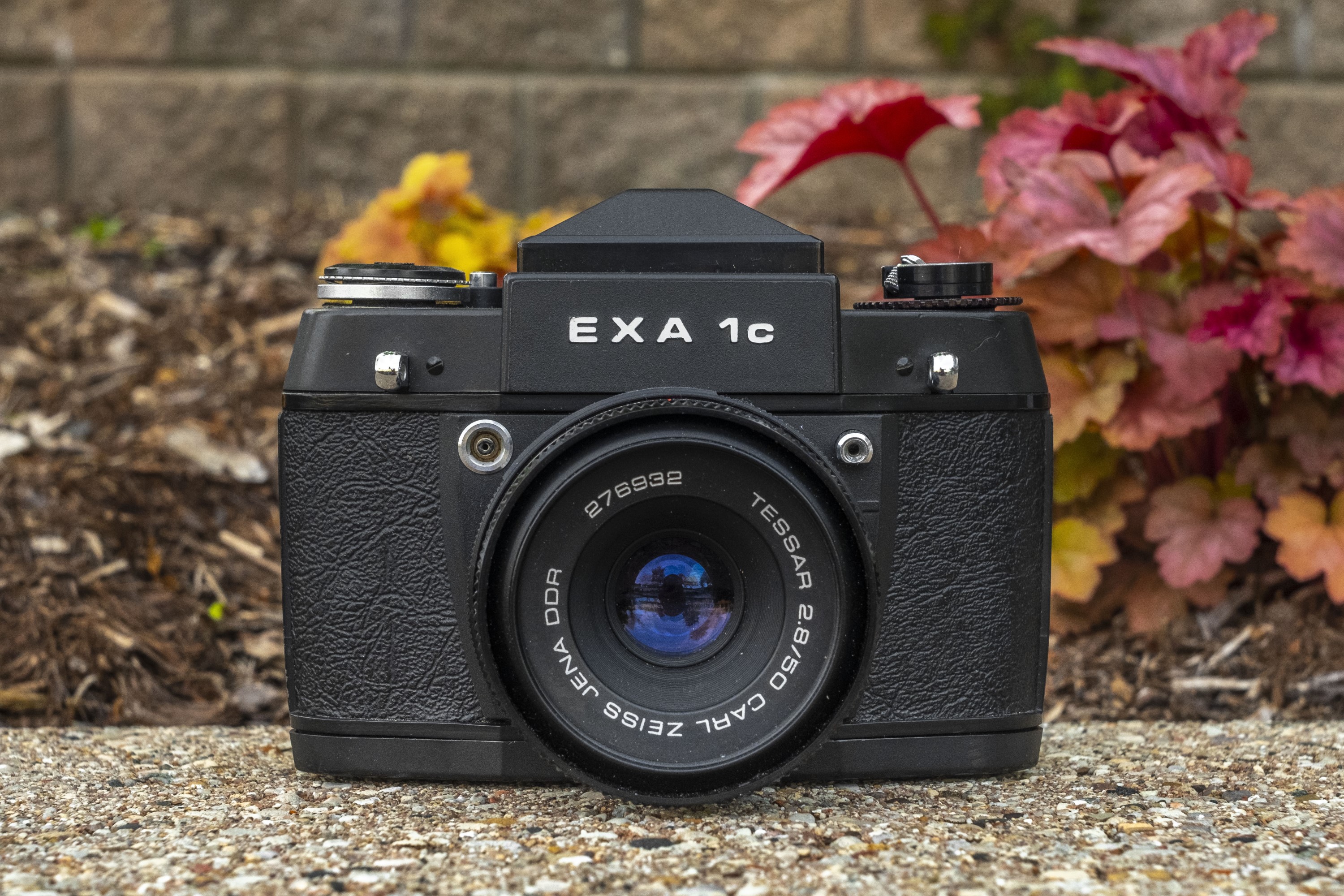
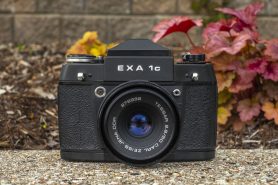
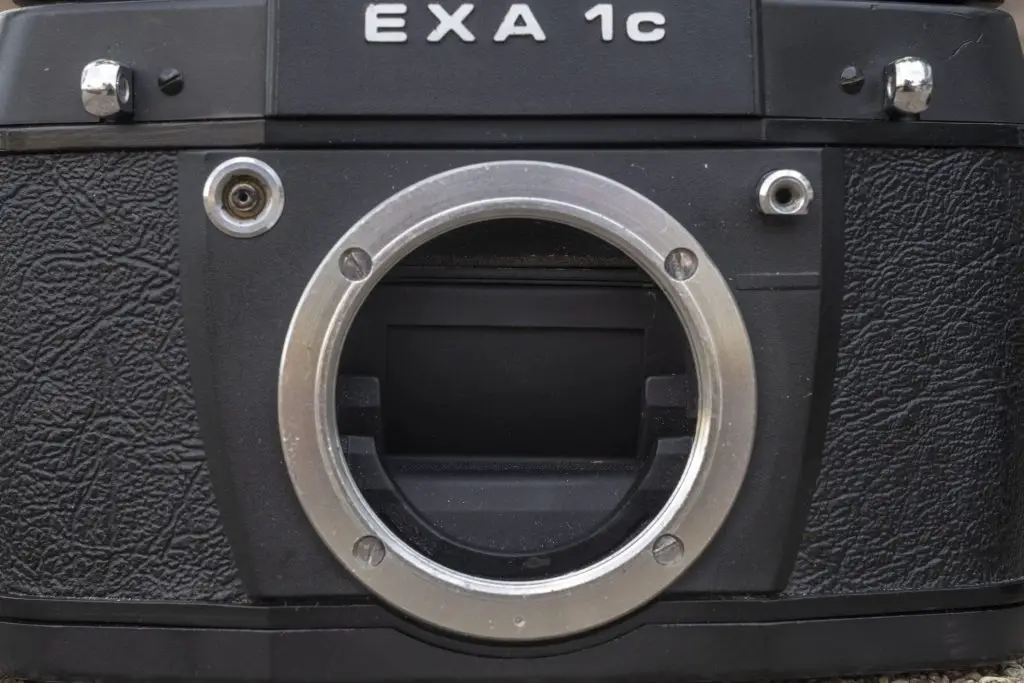
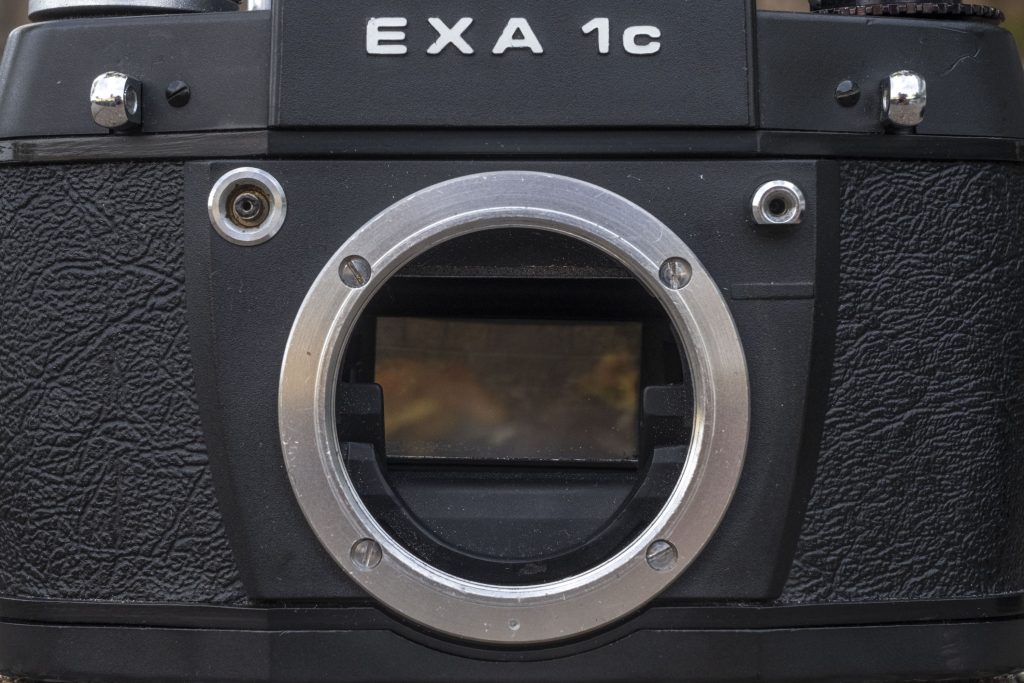
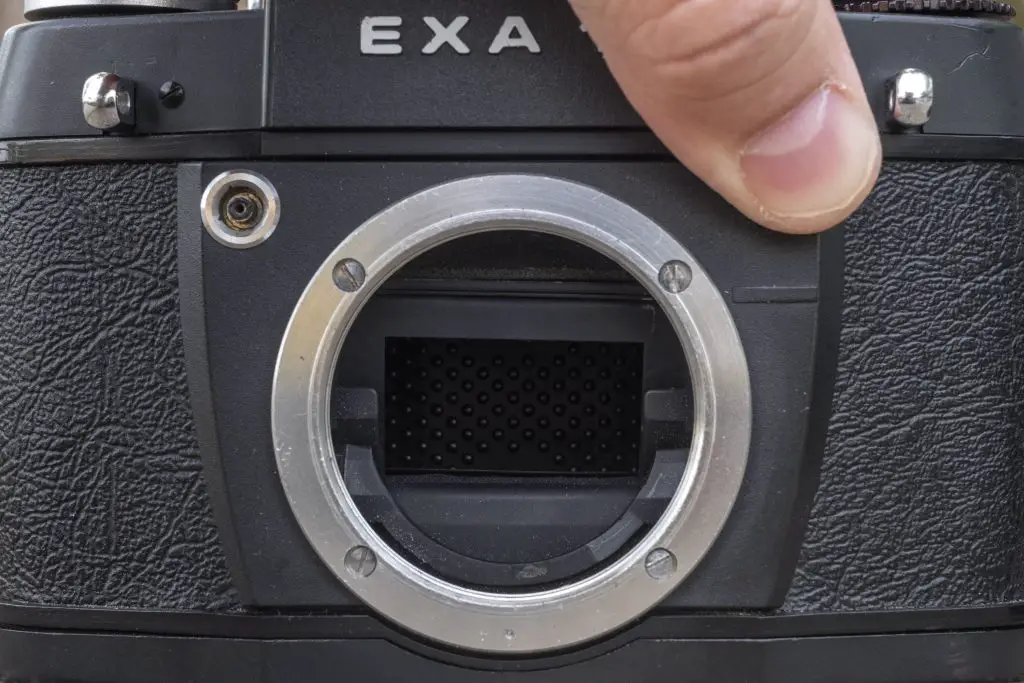











Nice write up! I had an Exa I gave away a few weeks ago, its new owner (her first camera that’s not a smartphone) is very happy with it. Word of caution though: do NOT use Takumar lenses designed for the Spotmatic. These lenses have a couple of extra to allow open aperture metering, including a tiny pin that presses against the mount. That pin WILL get stuck in the screw holes in the Exa mount, trapping your lens for good in a position you can’t even use it! The only way to get it unstuck is to take apart the lens untile you can actually pull that pin off its awkward situation. Can be done – I am not the first one to whom this has happened, but there are more useful ways to spend one’s time and repairing skills 🙂
Thanks for the tip on not using Takumar lenses! I’ve encountered other strange compatibility issues between two lenses of similar mount, but never M42. I tried to shoot a Schneider Xenon lens in Exakta mount on a Topcon RE Super which also has an Exakta mount and although the lens mounted, at infinity, the rear lens element would protrude into the mirror box just enough to hit the mirror when firing the shutter. With closeups or even focused to about 8-10 feet it was OK, but infinity was no bueno.
The lenses to avoid are those designed for the Spotmatic F, and other full open metering variants of the Spotmatic – these have a guard pin on the lens mount which prevents manual mode being selected if the lens is mounted on a Spotmatic F. This pin drops into one of the screw holes on the face of the Exa lens mount (the same happens with Zenit and some Mamiya cameras). Spotmatic lenses without the guard pin are fine on the Exa.
Speaking as one who has dismantled and serviced a few Takumars, it’s possible to hold down that guard pin with a fingernail, and switch the lens to manual operation … then just leave the selector on “manual” for subsequent repair or shooting.
Why buy an exa? Simple, it’s very simple and very reliable, what other camera can you buy for this sort of price with interchangeable wlf and eye level finders that takes such a variety of interesting lenses that will work for ever? The most it is likely to need in the way of repairs is cleaning the shutter mechanics with some ronsonol, no light seals or fabric shutter blinds to deteriorate. I use my 1b in conjunction with an olympus epm1 with m42 adaptor and loads of m42 lenses, very nice for portrates with a zeiss 135mm, street views etc. with a pentacon 28mm, bokeh with a helios 44…….
Nice review! The Eastern bloc citizens had vastly different expectations in terms of quality and technological advancement. Think trabant cars. Even the prakticas of the mid eighties were still using 1950s technology. The populace got what they were given. And yet now we have holgas, and hipsters. Its a funny old world!
I like my Exa C1a, it feels good and solid in my hands. It is new addition to my collection of cameras from a Kodak vest pocket to a digital Nikon Z5. I have only just put a film in it and look forward to using the camera and seeing the results when I process the film. One particular feature which appeals to me is the WLF, especially good for portraits. Also, the shutter lock is a very good idea. Hope to share results if possible. Excellent review, but nothing wrong with having a very basic camera, the rest is up to the photographer!
JDP, Greece.
I agree with your assessment. I’m assuming your Exa has the same M42 Tessar like mine did, and of course Tessars are well regarded for producing excellent images. The biggest con to that camera is the limited number of shutter speeds, but as long as you work within what it can do, you’ll be happy with the results.
hey i am having a problem , i bought a relatively new Exa 1c , and bought a Agfa 100 bw film just for testing , the camera shutter etc work fine , i had the the film correctly as well . But unfortunately all is blank , i am really unable to find any cause that why are the negatives black.Requesting your kind help
It’s hard to say without being able to inspect the camera. The Exa has a very simple guillotine shutter that is usually pretty reliable. Apart from someone accidentally exposing the film to light before it was developed, the only thing that would cause all blank exposures is a shutter that’s not opening. When you open the back of the camera and look through the film gate while firing the shutter, do you see light coming through?
Thank you for a great review Mike! Based on this review and some of the comments above, I just bought an Exa 1C of my own and absolutely love it. I already have a couple of Praktica L series in my collection, so I have a few M42 lenses to use with it. Right now it has a KMZ Industar 50 “pancake” lens on it at the moment and it is a good fit. Question, with the unique action of the shutter/mirror, is it still okay to keep the camera in storage with the shutter uncocked? I was always taught never to leave the shutter cocked for long periods of time (and the camera came to me cocked), but I wasn’t sure if that would allow the mirror to get stuck over time. Thanks for the great articles!